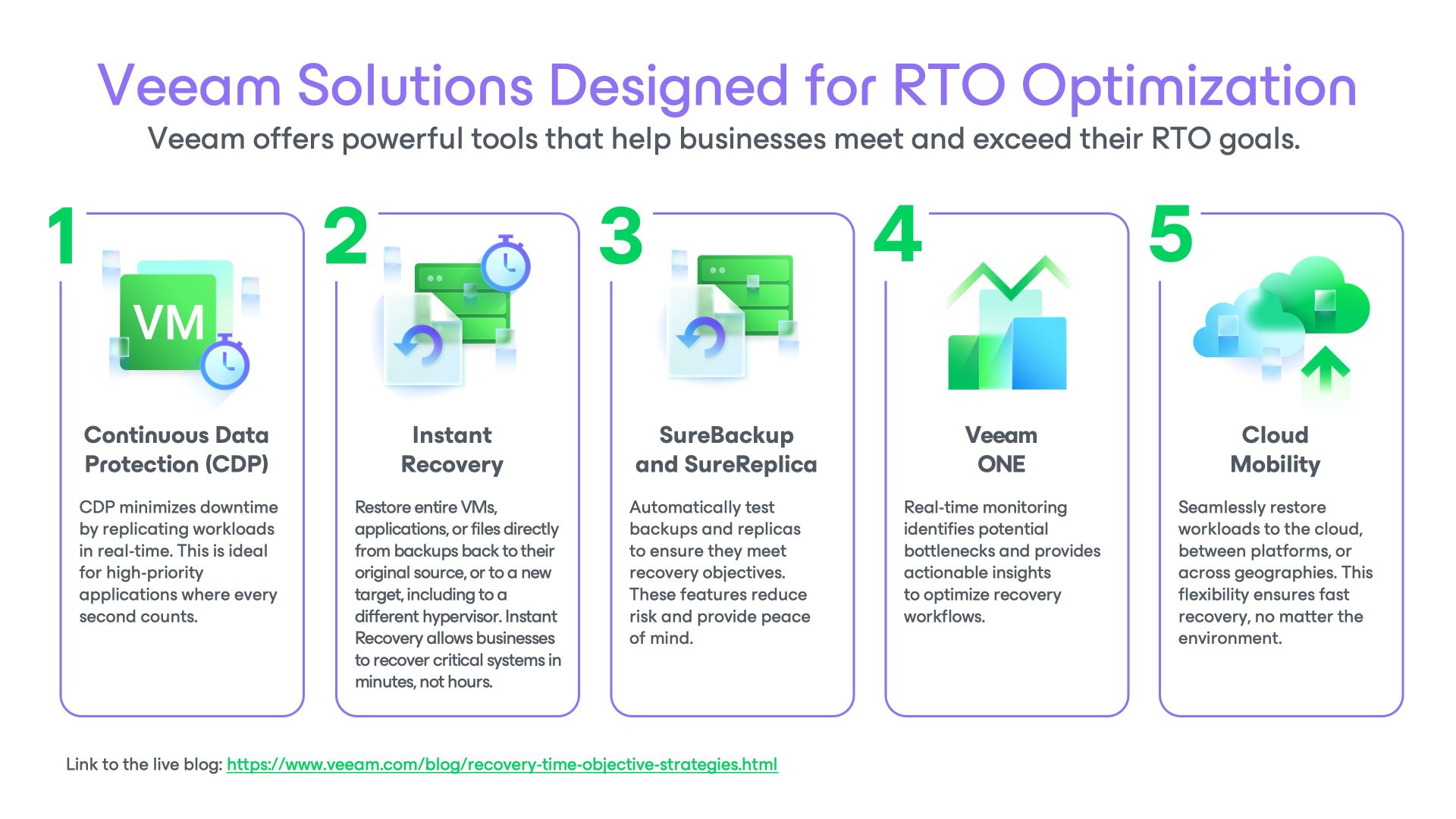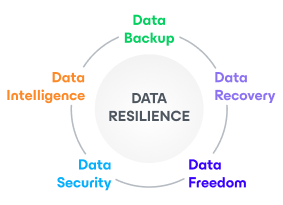Key Takeaways:
- RTO defines your maximum tolerable downtime: it’s the target time to restore systems, applications, or processes after a disruption, ensuring business continuity.
- RTO is business‑driven, not technology‑only: determine acceptable downtime by assessing operational impact, customer expectations, compliance requirements, and financial risk.
- Critical systems come first: prioritize recovery for workloads that directly affect revenue, customer satisfaction, or regulatory compliance.
- Test and validate regularly: conduct disaster recovery drills to confirm actual recovery times meet your defined RTOs.
- Leverage tiered recovery plans: use different recovery methods for different system priorities (e.g., instant restore for mission‑critical apps, longer restore for archival data).
- Integrate RTO into your broader resilience strategy: pair it with Recovery Point Objective (RPO) and incident response planning for full disaster recovery readiness.
Imagine this: your business-critical application goes offline unexpectedly. Every minute of downtime could mean lost revenue, frustrated customers, and operational chaos. The question is — how quickly can you recover? This is where Recovery Time Objective (RTO) becomes critical.
In this blog, we’ll dive into actionable strategies for optimizing your RTO, discuss real-world scenarios, and showcase how Veeam solutions empower businesses to recover faster and smarter. Whether you’re an IT professional or a decision-maker in charge of business continuity, this guide will provide the insights you need to keep your business running with minimal disruption.
What is Recovery Time Objective?
Recovery Time Objective defines the maximum amount of time a system or application can remain offline before business operations are severely disrupted. It’s not a theoretical number—it drives real decisions about backup technologies, disaster recovery plans, and infrastructure investments.
For example:
- Healthcare providers may require systems like electronic health records (EHR) to recover almost instantly, as downtime can impact patient care.
- E-commerce platforms might need an RTO of minutes to avoid lost sales during peak shopping events.
- Manufacturers could tolerate hours of downtime for non-critical systems but need faster recovery for production line software.
RTO is part of a broader disaster recovery strategy, working alongside Recovery Point Objective (RPO), which focuses on the acceptable amount of data loss. Together, they shape how businesses prepare for outages and respond when they happen.
Why RTO is Critical to Business Continuity
When systems go offline, the ripple effects extend far beyond the IT department.
- Operational disruption: Employees can’t access tools or data, leading to delayed projects and missed deadlines.
- Financial loss: Downtime costs can range from a few thousand dollars per hour for small businesses to millions for enterprises.
- Reputational damage: Customers expect reliability. Repeated outages can erode trust, pushing clients to competitors.
- Compliance risks: Many industries, such as finance and healthcare, have strict regulations around availability. Failing to recover within the specified RTO can result in fines or legal consequences.
Defining RTO ensures resources are focused where they’re needed most, helping businesses recover faster and mitigate long-term impacts.
Common Challenges in Meeting RTO Goals
While RTO is essential, achieving it can be difficult. Businesses often encounter:
- Limited infrastructure: Older hardware or insufficient bandwidth slows down recovery efforts.
- Unverified recovery plans: Without testing, recovery plans can fail or take longer than expected.
- Complex environments: Managing multiple platforms, applications, and dependencies makes it harder to prioritize and streamline recovery.
Overcoming these challenges requires careful planning and modern solutions designed for speed and reliability.
Proven Strategies to Optimize RTO
Reducing downtime isn’t just about technology — it’s about having the right processes in place.
1. Automate Recovery Processes
Manual steps introduce delays and increase the risk of error during recovery. Automating workflows ensures consistency and speed. With tools like Veeam Data Platform, businesses can automate backup verification and orchestration, reducing recovery times significantly.
2. Use Instant Recovery Technology
Instant VM Recovery restores systems directly from backups, eliminating the waiting time associated with traditional full recoveries. Whether it’s an application, file, or virtual machine, this approach minimizes downtime and keeps operations running.
3. Classify and Prioritize Workloads
Not all systems require the same recovery urgency. Businesses should group applications into tiers:
- Tier 1: Critical systems that must be restored within minutes (e.g., customer-facing applications).
- Tier 2: Important but less urgent systems that can recover within hours (e.g., internal reporting tools).
By focusing resources on critical workloads, businesses can achieve tighter RTOs for the systems that matter most.
4. Test and Simulate Regularly
A recovery plan is only as good as its last test. Simulating disaster scenarios helps identify gaps and ensures readiness when outages occur. Solutions like SureBackup automate application and workload testing, verifying backup integrity and ensuring smooth recovery. For testing at-scale, Veeam Recovery Orchestration allows customers to build and test site recovery plans.
5. Leverage Scalable Infrastructure
Modern recovery requires robust infrastructure. Investing in high-performance hardware and cloud-based solutions ensures scalability and reduces recovery bottlenecks.

Real-World Examples of RTO Success
E-Commerce: Black Friday Rescued in Minutes
A global retailer’s website went down during their busiest shopping day of the year. Using Instant Recovery, they restored operations in under 10 minutes, preventing millions in lost sales.
Healthcare: Patient Data Restored Safely
A ransomware attack locked a hospital’s electronic health record system. With immutable backups and SureBackup, the IT team quickly identified a clean restore point, ensuring uninterrupted care.
Finance: Meeting Tight Compliance Standards
A trading platform suffered a critical outage during market hours. Leveraging CDP, the institution recovered within 5 seconds, avoiding penalties and protecting investor confidence.
Every second counts after an outage.
Learn how Veeam can help you minimize downtime and achieve your recovery time objectives:
Frequently Asked Questions
1. What’s the difference between RTO and RPO?
RTO focuses on the time it takes to recover a system after an outage. RPO defines the acceptable amount of data loss during recovery.
2. Can RTO vary by system?
Yes. Critical systems typically require shorter RTOs, while less essential applications can tolerate longer recovery times.
3. How often should RTO goals be reviewed?
Review RTOs at least annually or whenever there’s a significant change in business operations, infrastructure, or compliance requirements.
4. What tools can help improve RTO?
Tools like Veeam Data Platform and Continuous Data Protection (CDP) are designed to minimize downtime and accelerate recovery times.

